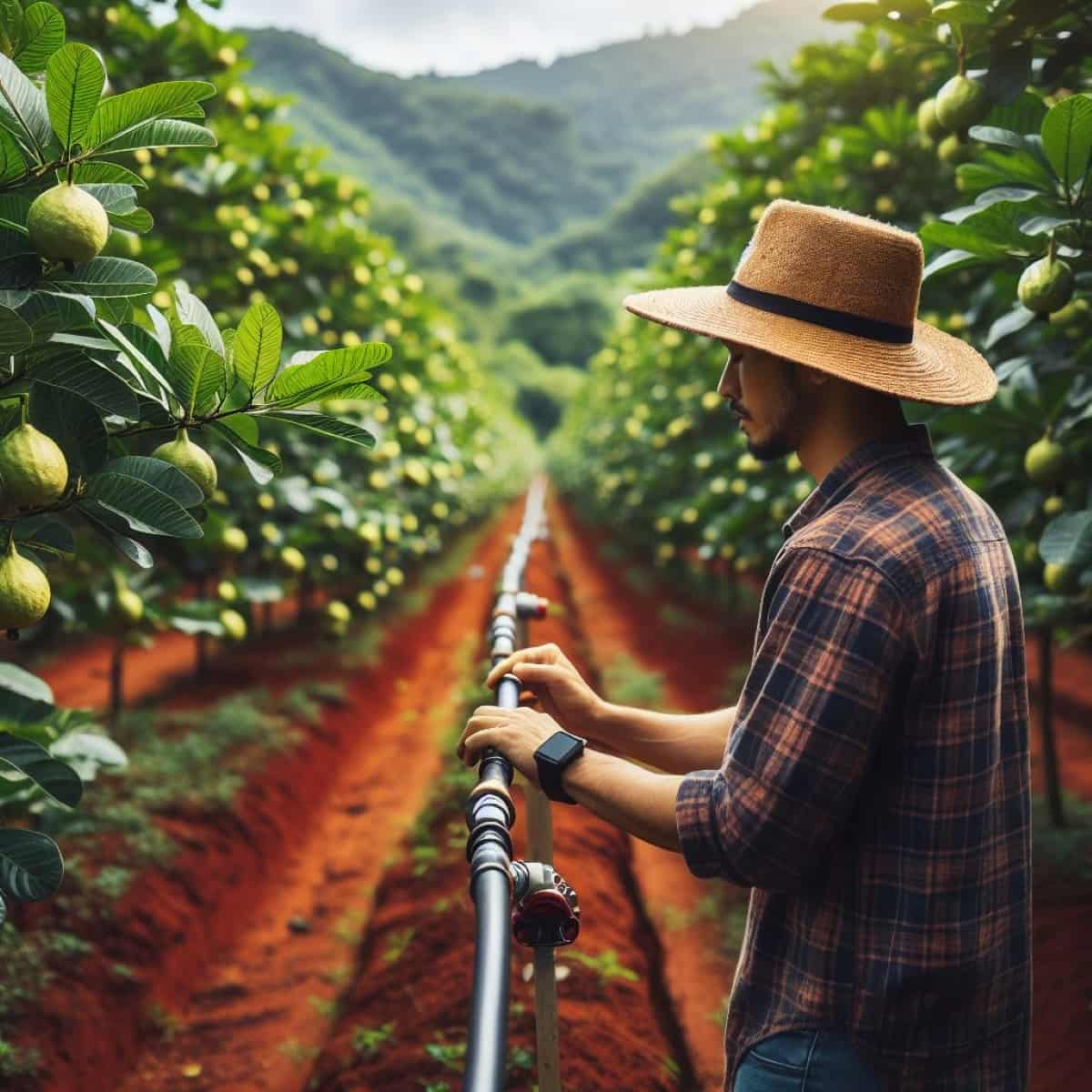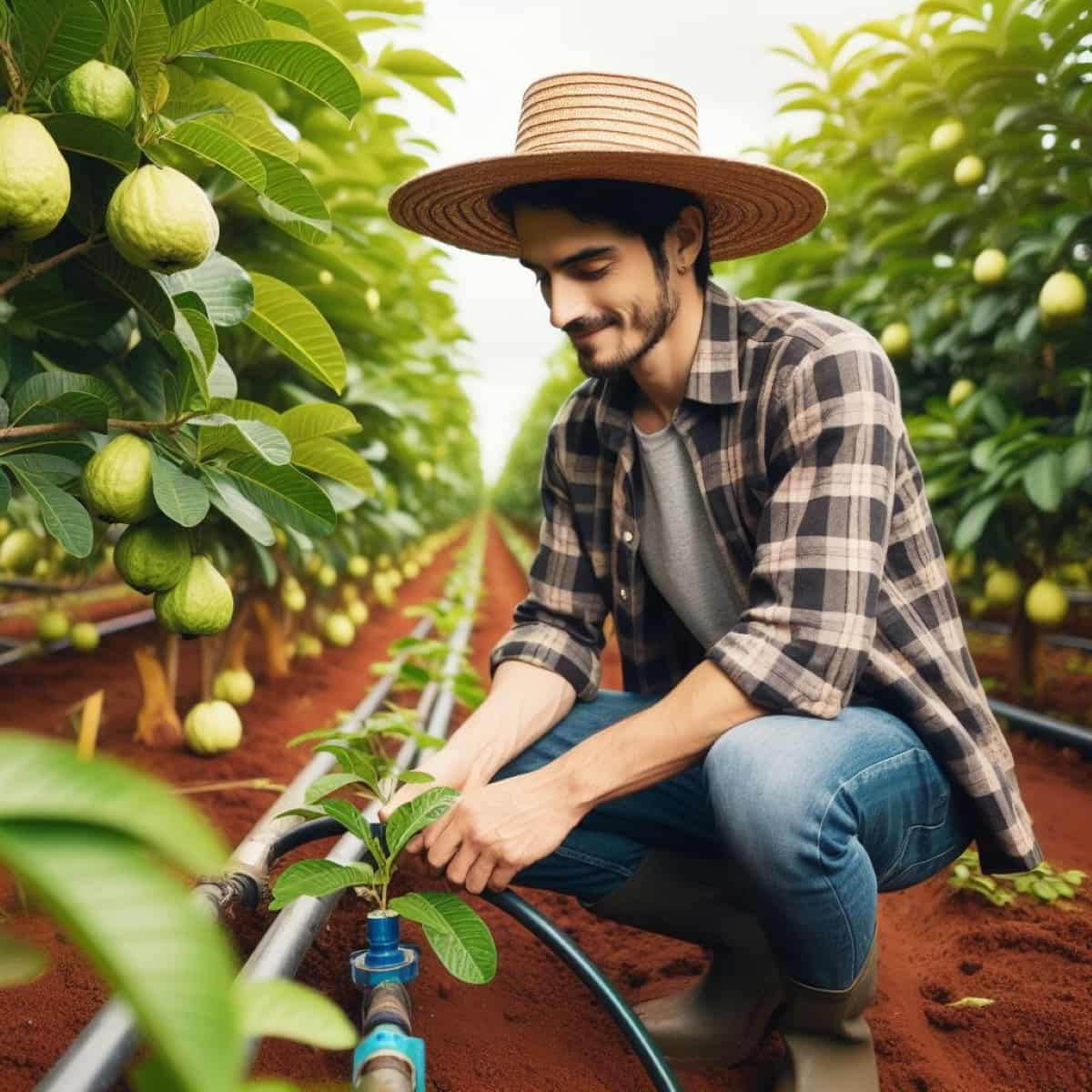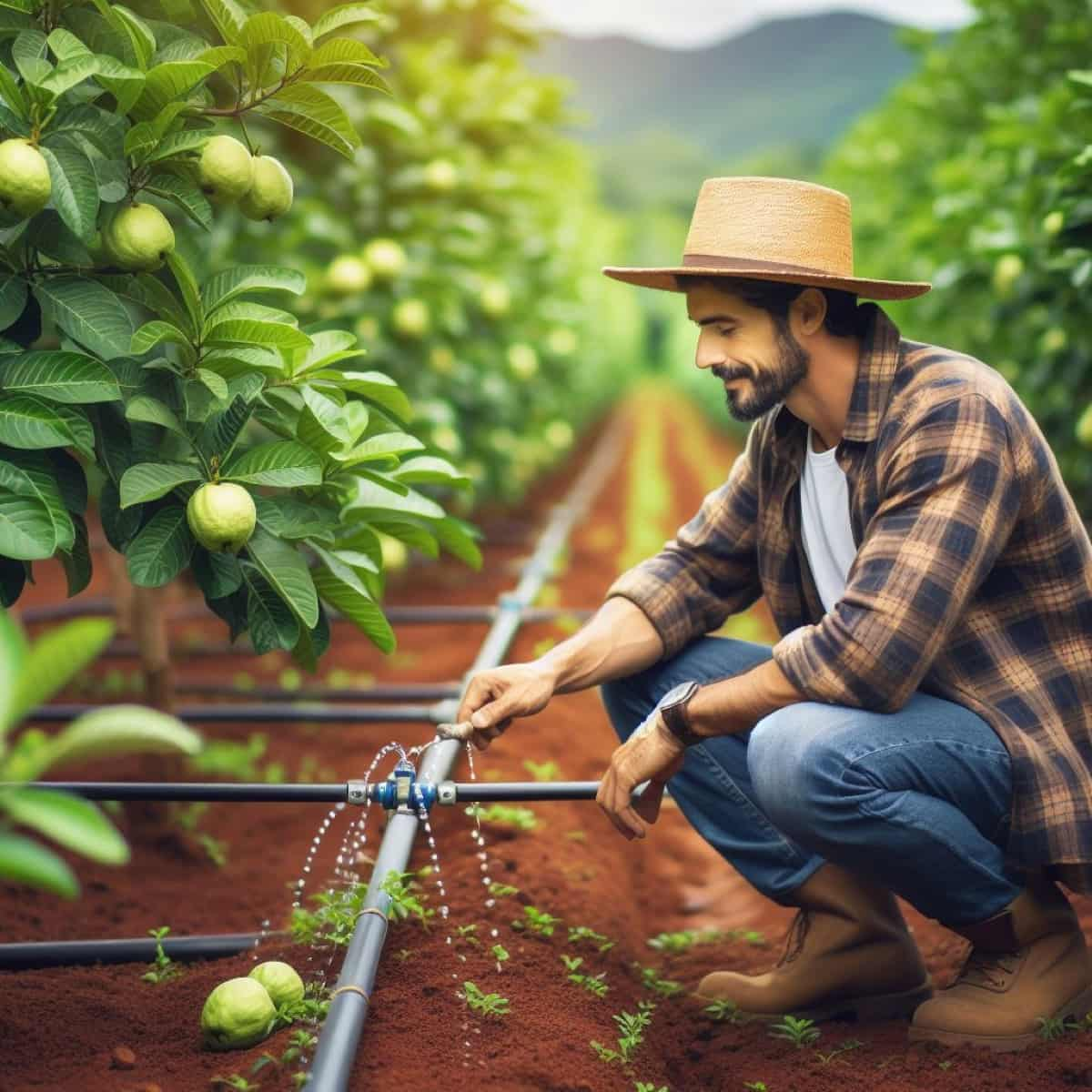Implementing drip irrigation in a guava plantation involves a multifaceted initial investment. The primary expenses include the procurement and installation of the drip irrigation system, which comprises drip lines, emitters, filters, pumps, and control systems. The cost varies based on factors like the size of the plantation, topography, and water source. On average, the initial investment for drip irrigation in a guava plantation can range from Rs. 90,000 to Rs. 1,30,000 per acre.

This encompasses the expenses related to materials, labor, and equipment. Additionally, it’s crucial to consider ongoing operational costs, such as maintenance, electricity for pumps, and periodic replacements of filters and emitters. While the initial investment cost may seem significant, the long-term benefits, including water efficiency and increased crop yield, often outweigh the upfront expenses.
Cost of Drip Irrigation Per Acre for Guava
Evaluate the Cost of Drip Lines and Emitters for Guava Fields
The cost of drip lines and emitters constitutes a major portion of the overall investment in a drip irrigation system for guava fields. Drip lines, typically made of high-quality polyethylene, and emitters, which regulate water flow to individual plants, vary in cost based on factors like brand, quality, and quantity.
On average, the cost of drip lines can range from Rs. 8,000 to Rs. 15,000 per acre, depending on the specifications and length required. Emitters, which are essential for controlled water delivery to guava plants, contribute an additional cost ranging from Rs. 5,000 to Rs. 10,000 per acre.
Analyze the Expense of Filters and Pressure Regulators in Drip Irrigation Systems
Filters and pressure regulators are crucial components in drip irrigation systems for guava farming, ensuring the efficient and uniform distribution of water to plants. The cost of filters is influenced by factors like the type (screen, disc, or sand filters), capacity, and quality. On average, the expense for filters can range from Rs. 10,000 to Rs. 20,000 per acre.
Pressure regulators, which maintain optimal water pressure throughout the system, contribute an additional cost ranging from Rs. 5,000 to Rs. 10,000 per acre. Invest in high-quality filters and regulators to prevent clogging and ensure the longevity of the drip system.
Estimate the Cost of Automation and Control Systems in Drip Irrigation for Guava
Automation and control systems enhance the efficiency of drip irrigation in guava farming by enabling precise scheduling and monitoring. The cost of these systems depends on factors such as the level of automation, sensor technology, and connectivity. On average, the expense for automation and control systems can range from Rs. 15,000 to Rs. 30,000 per acre. These systems allow farmers to optimize water usage, adjust irrigation schedules, and remotely monitor the entire system, contributing to better resource management and increased productivity.
Assess the Price of Pumps and Pumping Stations for Drip Irrigation in Guava Farming
Pumps and pumping stations play a vital role in delivering water from the source to the drip irrigation system. The cost of pumps depends on factors like capacity, power, and brand reputation. On average, the expenses for pumps and pumping stations can range from Rs. 30,000 to Rs. 50,000 per acre.
In case you missed it: How to Prevent Guava Fruit Rot Naturally: Best Ways to Control with Natural and Organic Treatment

Investing in energy-efficient pumps can result in long-term cost savings. Additionally, proper sizing and maintenance of pumps are crucial for the overall effectiveness of the drip irrigation system. Farmers should carefully evaluate their water source and irrigation requirements to select the most suitable pumps for their guava plantation, considering factors like water availability and desired flow rates.
Explore the Cost of Fertilizer and Nutrient Injection Systems in Drip Irrigation for Guava
Integrating fertilizer and nutrient injection systems into drip irrigation enhances soil fertility and plant nutrition. The cost of these systems depends on the type of injectors, the complexity of nutrient solutions, and the scale of the guava plantation. On average, the expense for fertilizer and nutrient injection systems can range from Rs. 20,000 to Rs. 40,000 per acre.
These systems allow farmers to precisely deliver essential nutrients to guava plants, promoting healthy growth and maximizing yield. While the initial investment is notable, the long-term benefits, in the form of productivity increase and improved fruit quality, often justify the expense.
Calculate the Labor and Installation Costs for Drip Irrigation in Guava Plantations
Labor and installation costs are integral components of the overall investment in drip irrigation for guava plantations. The expenses include the workforce required for system installation, trenching, laying pipes, and connecting various components. On average, the labor and installation costs can range from Rs. 15,000 to Rs. 25,000 per acre.
Factors influencing these costs include the topography of the land, soil conditions, and the complexity of the irrigation system. Efficient installation is crucial for the proper functioning of the drip system, ensuring uniform water distribution across the guava plantation.
Factor the Maintenance and Repair Expenses for Drip Irrigation Systems in Guava Farming
Regular upkeep involves cleaning filters, inspecting emitters, and monitoring system performance. On average, the annual maintenance and repair expenses can range from Rs. 5,000 to Rs. 10,000 per acre. Timely repairs and preventive maintenance are essential to extend the lifespan of the system and avoid productivity disruptions. Farmers should allocate funds for routine checks, spare parts, and occasional repairs to ensure the continuous and efficient operation of the drip irrigation system throughout the guava farming season.
In case you missed it: Organic Farming Costs Per Acre: Comparative Analysis with Conventional Farming Costs

Energy Costs Associated with Drip Irrigation in Guava Cultivation
Drip irrigation in guava cultivation requires energy to power pumps and, if applicable, automation and control systems. Factors like pump efficiency, system automation, and the duration of operation influence energy costs. On average, energy costs can range from Rs. 8,000 to Rs. 15,000 per acre.
Utilizing energy-efficient pumps, adopting solar-powered solutions, and optimizing irrigation schedules can help manage and potentially reduce these costs. Although there are energy expenses, the water savings and increased crop yield associated with drip irrigation often outweigh the energy-related expenditures.
Government Subsidy for Guava Drip Irrigation
In many regions, government subsidies aim to promote water-efficient agricultural practices, including drip irrigation. Farmers engaged in guava cultivation can access subsidies that offset a portion of the initial investment. These subsidies may cover 45 to 50 % of expenses related to drip lines, emitters, pumps, and other components.
The subsidy amount varies based on government policies and agricultural support programs. Farmers are encouraged to engage with local agricultural authorities to understand eligibility criteria and application processes for these subsidies, making the adoption of drip irrigation more financially accessible.
Compare the Overall Operational Costs of Drip Irrigation vs. Traditional Methods in Guava Farming
When comparing the overall operational costs of drip irrigation to traditional methods in guava farming, several factors come into play. Drip irrigation, despite its initial investment, often proves more cost-effective in the long run. It minimizes water wastage, reduces labor for manual watering, and enhances nutrient delivery, leading to increased yields.
In case you missed it: 9 Causes of Dying Guava Tree and How to Fix It?

While traditional methods may seem less expensive initially, the cumulative costs of manual labor, higher water consumption, and potentially lower yields can offset the apparent savings. Drip irrigation’s efficiency, potential government subsidies, and long-term benefits make it a financially viable and sustainable choice for guava farmers looking to optimize their operational costs and improve overall profitability.
Conclusion
In conclusion, adopting drip irrigation in guava plantations involves an initial investment covering various components such as drip lines, emitters, filters, pumps, and control systems. Government subsidies can significantly offset these costs, making the transition economically feasible. While the upfront expenses may seem substantial, the long-term advantages include water efficiency and increased yield.
- Feed Your Flock for Less: Top 10 Tips to Save on Chicken Feed
- Ultimate Guide to Ossabaw Island Hog: Breeding, Raising, Diet, and Care
- Hatching Answers: The Top 10 Reasons Your Chickens Aren’t Laying Eggs
- Eggs and Economics: Breaking Down the Cost of Raising Backyard Chickens
- Defend Your Greens: Proven Methods to Keep Iguanas Out of Your Garden
- Ultimate Guide to Cinnamon Queen Chicken: A Comprehensive Guide for Beginners
- Ultimate Guide to California Tan Chicken: Breeding, Raising, Diet, Egg-Production and Care
- Ultimate Guide to Marsh Daisy Chicken: Breeding, Raising, Diet, and Care
- 10 Types of Chicken Farming Businesses You Can Start for Profits